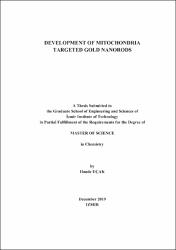Please use this identifier to cite or link to this item:
https://hdl.handle.net/11147/9625Full metadata record
| DC Field | Value | Language |
|---|---|---|
| dc.contributor.advisor | Özçelik, Serdar | - |
| dc.contributor.author | Uçak, Hande | - |
| dc.date.accessioned | 2020-08-24T11:51:37Z | |
| dc.date.available | 2020-08-24T11:51:37Z | |
| dc.date.issued | 2019-12 | - |
| dc.identifier.citation | Uçak, H. (2019). Development of mitochondria targeted gold nanorods. Unpublished master's thesis, İzmir Institute of Technology, İzmir, Turkey | en_US |
| dc.identifier.uri | https://hdl.handle.net/11147/9625 | - |
| dc.description | Text in English; Abstract: Turkish and English | en_US |
| dc.description | Thesis (Master)--Izmir Institute of Technology, Chemistry, Izmir, 2019 | en_US |
| dc.description | Includes bibliographical references (leaves: 55-58) | en_US |
| dc.description.abstract | Lung cancer has the largest number of lives for the global pattern of cancer death. However, the percentage of the cancer treatment is too low. Gold nanoparticles have a widely range in terms of biomedical applications in diagnosis, imaging because of their unique optical properties, simple synthesis techniques, biocompatibility and suitable for easy surface change. Redox reactions in the mitochondria generates a potential called as mitochondria membrane potential. The aim of the study is to design mitochondria targeted gold nanorods and to observe how the designed gold nanorods effects the mitochondria membrane potential by targeting the mitochondria on A549 and BEAS-2B cell lines. Gold nanorods were utilized by seed growth mediated method and the surface bioconjugation was performed with triphenyl phosphonium cation as a mitochondria targeted molecule. Poly (sodium-p-styrene sulfonate) was used to prevent aggregation during the bioconjugation process. Gold nanorods which had 30 nm x 10 nm in length and diameter depending on SEM images had well-defined absorption bands 513 nm and 774 nm in wavelength. Mito-pot analysis with the fluorescent intensity ratio and colocalization analysis with light intensity for targeting gold nanorods to mitochondria showed that the accumulation on mitochondria for TPP-GNR was higher than PSSGNR. TPP-GNR was more toxic than PSS-GNR for both of cell lines by investigations of MTT viability test. TPP-GNR targeted to mitochondria and it affected fundamental cellular functions in mitochondria. To concluded that accumulation on mitochondria was accomplished for TPP-GNR and the decreasing of mitochondria membrane potential was observed on this study. | en_US |
| dc.description.abstract | Akciğer kanseri kanser ölüm küresel desen için yaşamların en büyük sayıya sahiptir. Ancak, kanser tedavisinin yüzdesi çok düşüktür. Altın nano tanecikleri, benzersiz optik özellikleri, basit sentez teknikleri, biyouyumluluk ve kolay yüzey değişimi için uygun olması nedeniyle tanı, görüntüleme biyomedikal uygulamalar açısından geniş bir yelpazeye sahiptir. Mitokondrideki redoks reaksiyonları mitokondri membran potansiyeli olarak adlandırılan bir potansiyel oluşturur. Çalışmanın amacı mitokondri hedefli altın nanoçubukların tasarımı ve tasarlanmış altın nanoçubukları A549 ve BEAS-2B hücre hatları üzerinde mitokondrilerini hedefleyerek mitokondri membran potansiyelini nasıl etkilediğini gözlemlemektir. Altın nanoçubuklar tohum büyüme aracılı yöntemi ile sentezlenmiştir ve yüzey biyokonjugasyonu mitokondri hedefli molekül olan triphenyl fosfononyum katyonu ile yapılmıştır. Biyokonjugasyon işlemi sırasında agregasyonu önlemek için poli (sodyum-p-stiren sülfonat) kullanılmıştır. SEM görüntülerine bağlı olarak 30 nm x 10 nm uzunluğunda ve çapı olan altın nanoçubuklar, 513 nm ve dalga boyunda 774 nm iyi tanımlanmış emme bantlarına sahiptir. Floresan yoğunluk oranı ile mito-pot analizi ve altın nanoçubukların mitokondriye hedeflenmesi için ışık yoğunluğu ile kolokalizasyon analizi, TPP-GNR için mitokondri birikiminin PSS-GNR'den daha yüksek olduğunu göstermiştir. TPP-GNR, MTT canlılık testinin araştırılmasıyla her iki hücre hattı için de PSS-GNR'den daha toksiktir. TPP-GNR mitokondriyi hedef almıştır ve mitokondrideki temel hücresel fonksiyonları etkilemiştir. Bu çalışmada, TPP-GNR için mitokondri birikiminin gerçekleştiği ve mitokondri membran potansiyelinin azaldığı sonucuna varılmıştır. | en_US |
| dc.format.extent | xiii, 58 leaves | - |
| dc.language.iso | en | en_US |
| dc.publisher | Izmir Institute of Technology | en_US |
| dc.rights | info:eu-repo/semantics/openAccess | en_US |
| dc.subject | Gold nanoparticles | en_US |
| dc.subject | Mitochondria | en_US |
| dc.subject | Gold nanorods | en_US |
| dc.subject | Lung cancer | en_US |
| dc.subject | Biomedical applications | en_US |
| dc.title | Development of Mitochondria Targeted Gold Nanorods | en_US |
| dc.title.alternative | Mitokondri Hedefli Altın Nanoçubukların Geliştirilmesi | en_US |
| dc.type | Master Thesis | en_US |
| dc.institutionauthor | Uçak, Hande | - |
| dc.department | Thesis (Master)--İzmir Institute of Technology, Chemistry | en_US |
| dc.relation.publicationcategory | Tez | en_US |
| dc.identifier.wosquality | N/A | - |
| dc.identifier.scopusquality | N/A | - |
| item.grantfulltext | open | - |
| item.openairecristype | http://purl.org/coar/resource_type/c_18cf | - |
| item.fulltext | With Fulltext | - |
| item.cerifentitytype | Publications | - |
| item.languageiso639-1 | en | - |
| item.openairetype | Master Thesis | - |
| Appears in Collections: | Master Degree / Yüksek Lisans Tezleri | |
Files in This Item:
| File | Description | Size | Format | |
|---|---|---|---|---|
| 10187162.pdf | MasterThesis | 4.89 MB | Adobe PDF |  View/Open |
CORE Recommender
Items in GCRIS Repository are protected by copyright, with all rights reserved, unless otherwise indicated.